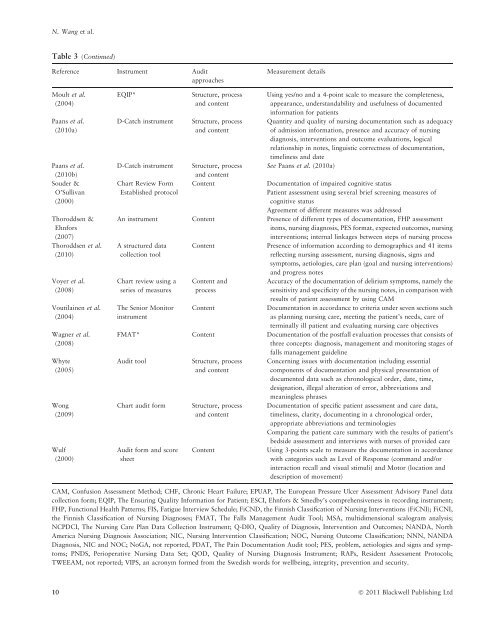Quality of nursing documentation and approaches to its evaluation ...
Quality of nursing documentation and approaches to its evaluation ...
Quality of nursing documentation and approaches to its evaluation ...
Create successful ePaper yourself
Turn your PDF publications into a flip-book with our unique Google optimized e-Paper software.
N. Wang et al.<br />
Table 3 (Continued)<br />
Reference Instrument Audit<br />
<strong>approaches</strong><br />
Measurement details<br />
Moult et al.<br />
(2004)<br />
Paans et al.<br />
(2010a)<br />
Paans et al.<br />
(2010b)<br />
Souder &<br />
O’Sullivan<br />
(2000)<br />
Thoroddsen &<br />
Ehnfors<br />
(2007)<br />
Thoroddsen et al.<br />
(2010)<br />
Voyer et al.<br />
(2008)<br />
Voutilainen et al.<br />
(2004)<br />
Wagner et al.<br />
(2008)<br />
Whyte<br />
(2005)<br />
Wong<br />
(2009)<br />
Wulf<br />
(2000)<br />
EQIP*<br />
D-Catch instrument<br />
D-Catch instrument<br />
Chart Review Form<br />
Established pro<strong>to</strong>col<br />
Structure, process<br />
<strong>and</strong> content<br />
Structure, process<br />
<strong>and</strong> content<br />
Structure, process<br />
<strong>and</strong> content<br />
Content<br />
Using yes/no <strong>and</strong> a 4-point scale <strong>to</strong> measure the completeness,<br />
appearance, underst<strong>and</strong>ability <strong>and</strong> usefulness <strong>of</strong> documented<br />
information for patients<br />
Quantity <strong>and</strong> quality <strong>of</strong> <strong>nursing</strong> <strong>documentation</strong> such as adequacy<br />
<strong>of</strong> admission information, presence <strong>and</strong> accuracy <strong>of</strong> <strong>nursing</strong><br />
diagnosis, interventions <strong>and</strong> outcome <strong>evaluation</strong>s, logical<br />
relationship in notes, linguistic correctness <strong>of</strong> <strong>documentation</strong>,<br />
timeliness <strong>and</strong> date<br />
See Paans et al. (2010a)<br />
Documentation <strong>of</strong> impaired cognitive status<br />
Patient assessment using several brief screening measures <strong>of</strong><br />
cognitive status<br />
Agreement <strong>of</strong> different measures was addressed<br />
An instrument Content Presence <strong>of</strong> different types <strong>of</strong> <strong>documentation</strong>, FHP assessment<br />
items, <strong>nursing</strong> diagnosis, PES format, expected outcomes, <strong>nursing</strong><br />
interventions; internal linkages between steps <strong>of</strong> <strong>nursing</strong> process<br />
A structured data<br />
collection <strong>to</strong>ol<br />
Chart review using a<br />
series <strong>of</strong> measures<br />
The Senior Moni<strong>to</strong>r<br />
instrument<br />
Content<br />
Content <strong>and</strong><br />
process<br />
Content<br />
Presence <strong>of</strong> information according <strong>to</strong> demographics <strong>and</strong> 41 items<br />
reflecting <strong>nursing</strong> assessment, <strong>nursing</strong> diagnosis, signs <strong>and</strong><br />
symp<strong>to</strong>ms, aetiologies, care plan (goal <strong>and</strong> <strong>nursing</strong> interventions)<br />
<strong>and</strong> progress notes<br />
Accuracy <strong>of</strong> the <strong>documentation</strong> <strong>of</strong> delirium symp<strong>to</strong>ms, namely the<br />
sensitivity <strong>and</strong> specificity <strong>of</strong> the <strong>nursing</strong> notes, in comparison with<br />
results <strong>of</strong> patient assessment by using CAM<br />
Documentation in accordance <strong>to</strong> criteria under seven sections such<br />
as planning <strong>nursing</strong> care, meeting the patient’s needs, care <strong>of</strong><br />
terminally ill patient <strong>and</strong> evaluating <strong>nursing</strong> care objectives<br />
FMAT* Content Documentation <strong>of</strong> the postfall <strong>evaluation</strong> processes that consists <strong>of</strong><br />
three concepts: diagnosis, management <strong>and</strong> moni<strong>to</strong>ring stages <strong>of</strong><br />
falls management guideline<br />
Audit <strong>to</strong>ol<br />
Chart audit form<br />
Audit form <strong>and</strong> score<br />
sheet<br />
Structure, process<br />
<strong>and</strong> content<br />
Structure, process<br />
<strong>and</strong> content<br />
Content<br />
Concerning issues with <strong>documentation</strong> including essential<br />
components <strong>of</strong> <strong>documentation</strong> <strong>and</strong> physical presentation <strong>of</strong><br />
documented data such as chronological order, date, time,<br />
designation, illegal alteration <strong>of</strong> error, abbreviations <strong>and</strong><br />
meaningless phrases<br />
Documentation <strong>of</strong> specific patient assessment <strong>and</strong> care data,<br />
timeliness, clarity, documenting in a chronological order,<br />
appropriate abbreviations <strong>and</strong> terminologies<br />
Comparing the patient care summary with the results <strong>of</strong> patient’s<br />
bedside assessment <strong>and</strong> interviews with nurses <strong>of</strong> provided care<br />
Using 3-points scale <strong>to</strong> measure the <strong>documentation</strong> in accordance<br />
with categories such as Level <strong>of</strong> Response (comm<strong>and</strong> <strong>and</strong>/or<br />
interaction recall <strong>and</strong> visual stimuli) <strong>and</strong> Mo<strong>to</strong>r (location <strong>and</strong><br />
description <strong>of</strong> movement)<br />
CAM, Confusion Assessment Method; CHF, Chronic Heart Failure; EPUAP, The European Pressure Ulcer Assessment Advisory Panel data<br />
collection form; EQIP, The Ensuring <strong>Quality</strong> Information for Patient; ESCI, Ehnfors & Smedby’s comprehensiveness in recording instrument;<br />
FHP, Functional Health Patterns; FIS, Fatigue Interview Schedule; FiCND, the Finnish Classification <strong>of</strong> Nursing Interventions (FiCNI); FiCNI,<br />
the Finnish Classification <strong>of</strong> Nursing Diagnoses; FMAT, The Falls Management Audit Tool; MSA, multidimensional scalogram analysis;<br />
NCPDCI, The Nursing Care Plan Data Collection Instrument; Q-DIO, <strong>Quality</strong> <strong>of</strong> Diagnosis, Intervention <strong>and</strong> Outcomes; NANDA, North<br />
America Nursing Diagnosis Association; NIC, Nursing Intervention Classification; NOC, Nursing Outcome Classification; NNN, NANDA<br />
Diagnosis, NIC <strong>and</strong> NOC; NoGA, not reported, PDAT, The Pain Documentation Audit <strong>to</strong>ol; PES, problem, aetiologies <strong>and</strong> signs <strong>and</strong> symp<strong>to</strong>ms;<br />
PNDS, Perioperative Nursing Data Set; QOD, <strong>Quality</strong> <strong>of</strong> Nursing Diagnosis Instrument; RAPs, Resident Assessment Pro<strong>to</strong>cols;<br />
TWEEAM, not reported; VIPS, an acronym formed from the Swedish words for wellbeing, integrity, prevention <strong>and</strong> security.<br />
10 Ó 2011 Blackwell Publishing Ltd

















